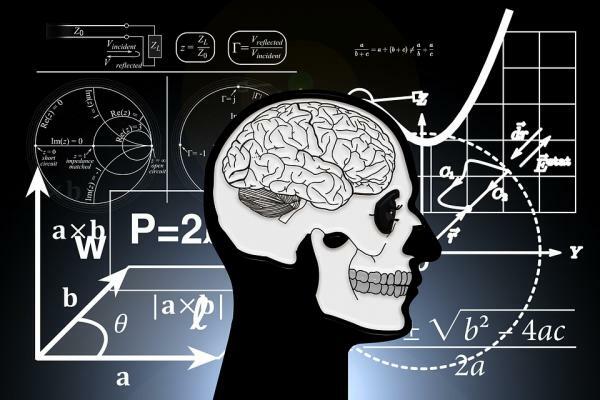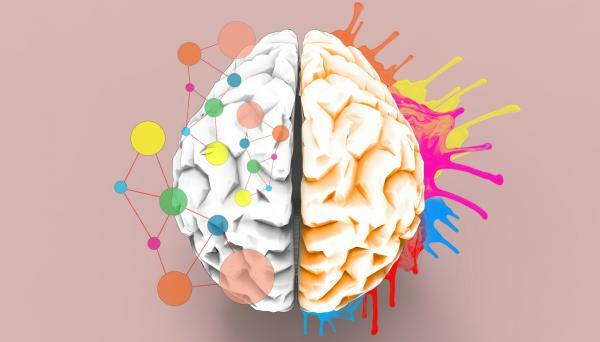
The savant or sage syndrome it is also called "idiot savant", which means" wise idiot ". It receives this name because people with savant syndrome suffer from a disability of the left hemisphere importantly, however, they can perform surprisingly well some tasks involving the hemisphere right.
People with savant syndrome develop talents, that is to say, extraordinary abilities in particular, concrete and peculiar. For example, a person with savant syndrome might not be able to manage money for everyday purchases, however, they may be able to answer correctly quickly and accurately questions such as: what day of the week will be March 3 of the year 2100?
In this Psychology-Online article about savant syndrome we explain what it is, its causes and characteristics, as well as the difference with asperger syndrome and autism and also some examples.
Index
- What is savant syndrome
- Characteristics and symptoms of savant syndrome
- Causes of savant syndrome
- Treatment of savant syndrome
- Difference between savant syndrome, autism, asperger's and Rett syndrome
- Examples of savant syndrome: Stephen Wiltshire and The good doctor
What is savant syndrome.
The savant syndrome is a syndrome that people with Asperger syndrome. Regarding Asperger's syndrome, although in the past it had been considered a completely part of autism and other pervasive developmental disorders, is currently included within the concept Autism Spectrum Disorders (ASD) and so it appears in the fifth edition of the Statistical and Diagnostic Manual of Mental Disorders (DSM-V)1. In addition to occurring in people with asperger syndrome, savant syndrome can occur in the context of brain damage, either due to illness or trauma. For this reason, savant syndrome usually occurs from birth but, depending on the cause, it can also be acquired, such as in cases of trauma.
The syndome of savant is characterized by presenting peculiar and impressive talents or abilities, such as hypermnesia, hyperlexia and hypercalculia, special abilities in handling the calendar and different artistic expressions such as drawing, painting, sculpture and music.
Is savant syndrome common?
The prevalence of savant syndrome is 1 in 10 people with Autism Spectrum Disorders and 1 in 1,000 people with brain damage or cognitive deficits. The sex ratio is approximately 1 girl for every 3 or 4 boys.
Characteristics and symptoms of savant syndrome.
The symptoms and characteristics that people with savant syndrome present are a below average cognitive functioning with one or more talents. They are characterized by having one or more highly developed specific capacities that are attributed to the right hemisphere. For example, the ability to calculate, artistic skills and hypermnesia, especially mechanical, visual, motor and spatial skills. While they suffer from a significant dysfunction in the skills that belong to the left hemisphere. For example, logical or symbolic skills and verbal skills.
Musical ability
Some people with savant syndrome have extraordinarily developed musical ability and are capable of interpret musical pieces either with an instrument or with the voice, without previous knowledge. In addition to interpreting they can also to compose pieces musicals.
Ability for the plastic arts
Some savant have a great capacity for art in its different forms: drawing, painting, sculpture, among others. The characteristics that stand out the most in his works are creativity and detail.
Mathematical ability
These are the most common but also the most spectacular skills. Savant with a high capacity for calculation and mathematics have an exceptional ability to solve calculations with great precision and speed.
All of these skills in which people with savant syndrome tend to excel have in common that they are closed systems governed by formulas. Therefore, they can be carried out rigidly and mechanically, that is, without involving the emotional part.
Types of savant syndrome
Three types of savant syndromes are considered:
- The savant prodigious They have great skills that excel in all areas of IQ, they are rare, in fact it is considered that there may be less than 25 cases worldwide.
- The savant with talent They have incredible abilities but also have great deficiencies in other cognitive areas.
- The savant of minutiae they have some specific and peculiar but limited abilities, as well as dysfunctionalities in other cognitive areas.
Intelligence in savant syndrome
The best known and most widely used test to measure intellectual capacity is the Wechsler Adult Intelligence Scale (WAIS). If such a test is administered to a savant, a score would come out that indicates an IQ well below the actual coefficient that the person has, the result would be non-assessable. The cause of this mismatch lies in the nature of the test statements, that is, understanding the instructions for the different tests implies interpreting linguistic information. Therefore, the low performance in the different tests is due to their disability in verbal skills. In order to really measure any ability in a savant it has to be a a test in which language ability does not interfere.

Causes of savant syndrome.
The causes of savant syndrome are diverse. In principle, Savant people suffer from a developmental disorder, an autism spectrum disorder, or some type of brain damage in the left cerebral hemisphere.
There is still no general agreement as to the cause of savant syndrome but there are different hypotheses. The main hypothesis is that damage to the left hemisphere causes the right hemisphere to develop more to compensate. In addition, a large part of people with savant syndrome also have an Autism Spectrum Disorder. One of the symptoms of ASD is have restricted interests, which may be the reason for the development of a particular skill in an exceptional way.
Treatment of savant syndrome.
The main treatment that will be carried out with a person with savant syndrome will not be for this syndrome itself, but rather directed at the larger cause or problem, which may be ASD or brain damage from multiple Causes.
In the case of ASD, those areas that the person is affected should be treated. Normally, cognitive rigidity, alterations in language, affectation of the social area and behavior patterns are treated. To do this, you need a plan personalized treatment that involves various health and education professionals. Regarding the psychological part, behavioral treatments are usually used that promote the disappearance of maladaptive behaviors and the incorporation of adaptive behaviors, as well as learning a communication system and skills training social.
In case of brain damage, it is usually worked with cognitive stimulation to maintain and improve the affected functions.
Once the main topic has been addressed, the most important goal of intervention for savant syndrome is Improve your quality of life. A skills stimulation in which they stand out so that they develop them to the maximum of their potential. The Savant's Exceptional Ability can also be used to improve other capabilities in which it presents more problems, such as the social area.
Difference between savant syndrome, autism, asperger's and Rett syndrome.
Savant syndrome and autism
The autism o Autism Spectrum Disorder (ASD), which is the current term, consists of a neurobiological developmental disorder that begins to appear in childhood and lasts a lifetime. The most characteristic symptoms are deficits in the social area and abnormalities in behavior. The relationship that ASD has with savant syndrome is that the latter occurs, in most cases, in the context of the former.
Savant and Asperger syndrome
The Asperger syndrome currently it is included within the ASD, therefore, the same happens with autism. The relationship between Asperger's syndrome and Savant's syndrome is that the latter occurs, in most cases, in the context of the former.
Savant syndrome and Rett syndrome
The rett syndrome it's a developmental neurobiological disorder which has a clear genetic basis and associated with the X chromosome, therefore, it mainly affects girls. The main symptoms of Rett syndrome are psychomotor impairment, stereotypes and affectation of the social area with severe language impairment and lack of interest in interactions social. Therefore, the differences between savant syndrome and Rett syndrome are many, but the main one is that Rett syndrome is a genetic disorder that causes multiple disabilities, while savant syndrome is a manifestation that can occur due to conditions previous.
Examples of savant syndrome: Stephen Wiltshire and The good doctor.
Stephen Wiltshire
Stephen Wiltshire is a British artist diagnosed with Autism Spectrum Disorder. Wiltshire is known worldwide and stands out for his great ability to reproduce landscapes you've only seen once accurately and in detail. Wiltshire is an example of savant syndrome.
The good doctor
Shaun Murphy, the protagonist of the series "The good doctor", is a young resident surgeon with Autism Spectrum Disorder. Shaun owns a special medical ability and extraordinary memory allowing you to perform the most complex medical diagnoses. Shaun from the series "The good doctor" is also an example of savant syndrome.

This article is merely informative, in Psychology-Online we do not have the power to make a diagnosis or recommend a treatment. We invite you to go to a psychologist to treat your particular case.
If you want to read more articles similar to Savant syndrome: characteristics, symptoms, causes and treatment, we recommend that you enter our category of Clinical psychology.
References
- American Psychiatric Association (APA). (2013). Diagnostic and Statistical Manual of Mental Disorders: DSM-5. Panamericana Medical Publishing, 2014.
Bibliography
- Etchepareborda, M. C., Díaz-Lucero, A., Pascuale, M. J., Abad-Mas, L., & Ruiz-Andrés, R. (2007). Asperger syndrome, the little teachers: special abilities. Revista De Neurologia, 44 (Suppl 2), 43-47.
- Mottron, L., Dawson, M., & Soulières, I. (2009). Enhanced perception in savant syndrome: patterns, structure and creativity. Philosophical transactions of the Royal Society of London. Series B, Biological sciences, 364 (1522), 1385-91.
- Fornazzari, L., Leggieri, M., Schweizer, T. A., Arizaga, R. L., Allegri, R. F., & Fischer, C. AND. (2018). Hyper memory, synaesthesia, savants Luria and Borges revisited. Dementia & neuropsychologia, 12 (2), 101-104.
- Muñoz-Yuntaa, J. A., Ortiz-Alonsob, T., Amob, C., Fernández-Lucasb, A., Maestúb, F., & Palau-Baduellc, M. (2003). The savant or idiot savant syndrome. Rev Neurol, 36 (Suppl 1), S157-S161.
- Tárraga Mínguez, R., & Fernández, G. (2007). Savant syndrome: between the great and the naive. Quaderns Digitals, 2007, vol. 45.
Savant syndrome: characteristics, symptoms, causes and treatment


